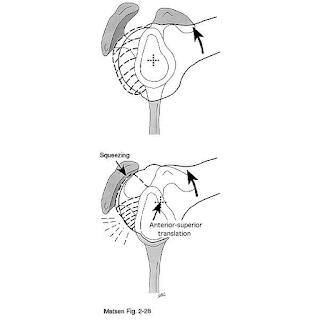Try this: reach your right hand behind your back and touch your fingers to your spine (go as high up as you can reach easily and comfortably). Now do the same thing with the left hand. Can you do it? Can you reach equally on both sides? You have just tested for tightness of the posterior capsule of the shoulder by internally rotating the arm.
The posterior capsule is a band of fibrous tissue that interconnects with tendons of the rotator cuff of the shoulder. The rotator cuff is made up of four muscles and their tendons. They cover the outside of the shoulder and form part of the posterior capsule to hold, protect, and move the joint.
If the posterior capsule is too tight, internal rotation motion of the shoulder can be limited. That type of shoulder tightness can lead to shoulder problems such as impingement, rotator cuff tears, and damage to the labrum. The labrum is an extra rim of fibrous cartilage around the otherwise shallow shoulder socket. It helps keep the shoulder in the joint and prevent dislocations.
Posterior capsular tightness pushes the humeral head forward out of the glenohumeral joint resulting in impingement between the rotator cuff and the anterior acromion.
What’s the best way to stretch the posterior capsule? That’s something physical therapists are studying. Patients with posterior shoulder tightness show up most often in a sports clinic. Athletes who can’t fully rotate the shoulder inwardly can be at a disadvantage in their sports performance. This is especially true for athletes involved in sports that require overhead throwing.
There have been some studies that support a stretching exercise for this problem. Others suggest performing a joint mobilization technique. Joint mobilization involves gliding and sliding the head of the humerus in the socket as far as it will go and gently rocking or oscillating it to gain mobility. Someone else (like a physical therapist) has to do this to you — it’s difficult to do it to yourself.
In this study, a group of therapists compare which works better: just the stretching technique or stretching combined with joint mobilization. They didn’t include a control group (people with this problem who don’t receive any treatment) or a group who just got mobilization. All the subjects were healthy college-aged adults. They each had at least a 10-degree difference in shoulder internal rotation from one side to the other. That’s why they were chosen for the study. None of the participants had any actual pain or other symptoms.
The programs were carried out over a period of four weeks. Everyone in both groups did the posterior capsule stretch. This was done by reaching the affected arm across the chest and using the hand on the uninvolved side to pull slightly and hold for 30 seconds. The stretch was repeated five times at least three to four days each week for the four weeks. Everyone filled out a log to post what days they did the exercises and how many they did.
For the people in the joint mobilization group, besides doing their stretches, a physical therapist also mobilized their involved shoulder for 10 minutes at least twice a week for four weeks. Results were measured and compared between the two groups using range-of-motion measurements for shoulder rotations (internal and external rotation were both measured). Measurements were taken at the end of the four-week treatment period and again four more weeks later (eight weeks after the start of the program).
No differences were noted in external rotation but internal rotation increased in both groups. This increase was observed right at the end of the four-week treatment period. Four weeks later, there was a loss of the internal rotation originally gained. The stretching plus mobilization group had the best results. At the end of the eight weeks, they had maintained more of the motion gained from treatment compared with the stretching only group.
What does this tell the therapists? For athletes (and other patients) with a tight posterior shoulder capsule, a stretching program may not be enough. They may have to add joint mobilization while continuing to have the patients stretch at home on their own.
The subjects in this study weren’t athletes, didn’t have any sports involvement, and had no known shoulder problems. So before jumping in and applying this new information, additional studies are going to have to be done. The procedures will have to be used on patients with diagnosed posterior shoulder capsule tightness associated with impingement or rotator cuff or labral lesions. This study was not able to compare the effects of the treatment on normal versus damaged tissue — that could make a difference in how effective stretching or stretching and joint mobilization might be.
On the prevention side of things, we know that athletes with limited internal shoulder range-of-motion are at risk for future shoulder injuries. Identifying those individuals with tight posterior shoulder capsules and putting them on a stretching program might help reduce injuries. Again, this is something that needs to be studied and confirmed (or disproven).
Reference:
Robert C. Manske, PT, DPT, et al. A Randomized Controlled Single-Blinded Comparison of Stretching Versus Stretching and Mobilization for Posterior Shoulder Tightness Measured by Internal Rotation Motion Loss. In Sports Health. March/April 2010. Vol. 2. No. 2. Pp. 94-100.
Thanks,
JTM, MD



